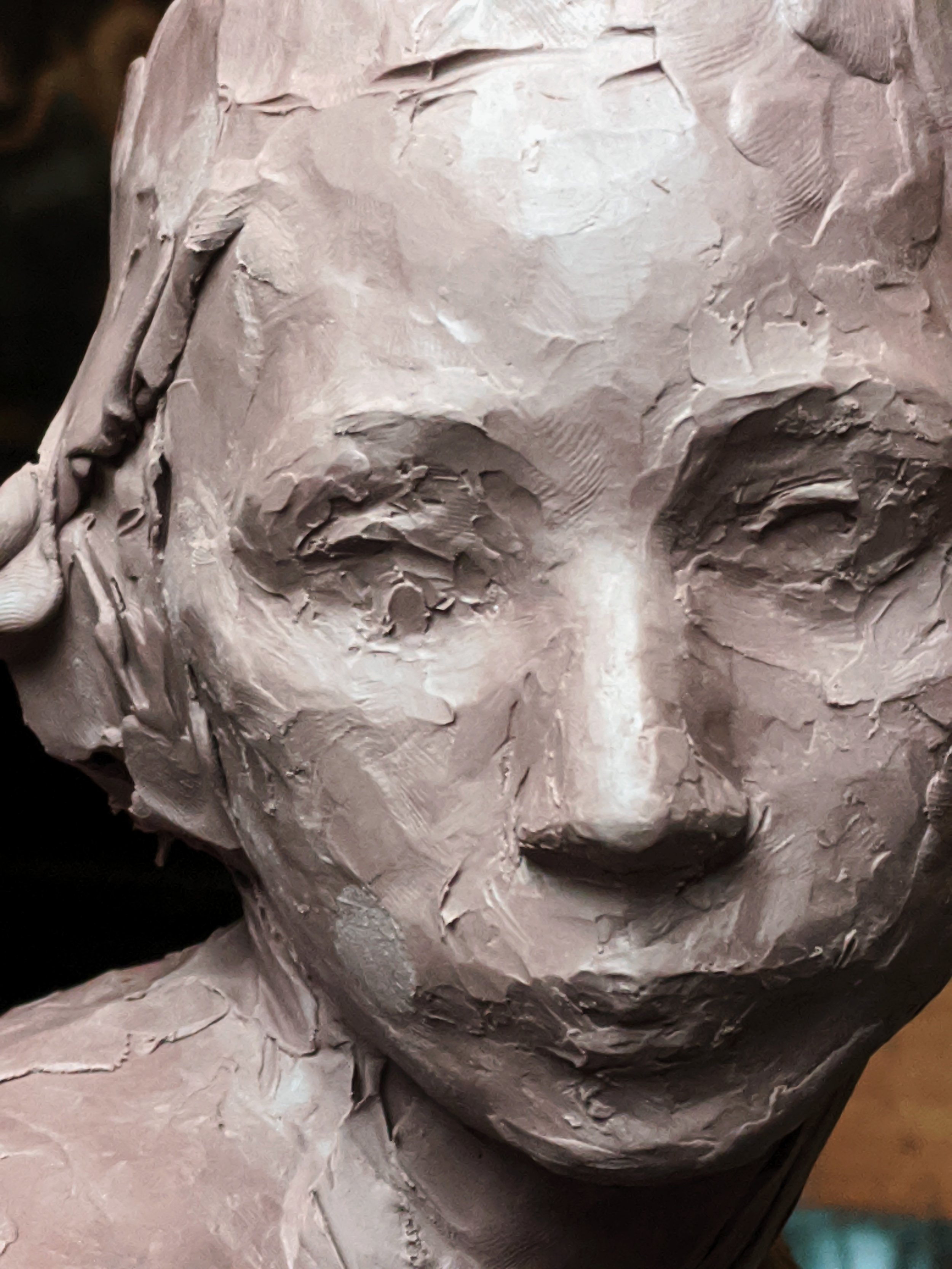I created these posters using images I shot throughout the casting process while preparing for my show, The Americans at Figure Ground Gallery in Seattle, WA . They provide insight into some of the beautiful moments I experience along the journey from idea to clay to bronze. Taken together with the text, they can tell the broad story of how a bronze is created, though there are myriad steps in between that I’ve not captured here. The show will be up throughout December 2023, please visit the gallery and see them in person alongside the completed bronzes.
Inspiration…
“Ideas for sculptures come in various ways. Often, I’m communicating a thought or feeling. Stacked Heads was inspired by a moment where I saw three separate The Builder heads piled on my workbench, with ceramic shell still clinging to the curls in the hair. I found the repetition soothing, while the varied angles
of each head created interest, excitement. Sometimes the industrial aesthetic of the foundry environment enhances the subtle beauty of a moment like this through contrast. I left much of the casting process apparent in the finished work as a reminder of the feeling of that original moment.”
Clay…
“Though sculptures can begin with a wide range of materials, clay is my preferred medium for working out compositions and ideas. It’s an incredible substance in that it can be pushed, stretched, or moved and maintain the shape it’s placed in spontaneously (a quality called “plasticity”). Because I create these figures from imagination, the identity of the subject isn’t static: a single character will morph many times as I struggle with who I want the character to become.”
Clay of The Builder in progress
Wax Work…
“The first step in lost wax bronze casting is to create a wax (using a mold in this case). The wax is a replica of the clay. It’s often surprising to students how much work needs to be done in the wax stage to prepare it for casting. For technical reasons, it’s often best to remove and cast separately certain parts of the wax, which will be welded back into place when the piece emerges as a bronze. Channels must be created to direct the bronze into the piece, and air out of the piece. Wax work is often a challenging puzzle, an aesthetic exercise, and a painstaking process. The appearance and design of the wax determines the quality of the final bronze in many ways.”
Click Here to see the completed bronze of Resting Equilibrium.
Gating the Wax…
“The wax will eventually become a negative space in the shell. Channels are designed to direct the flow of hot metal into the piece, allow wax and air to escape the shell, support the piece during the
subsequent stages, and minimize shrinkage of the bronze. Each sculpture being a unique shape, the gating has to be carefully considered for the challenges specific to that shape. Ultimately, it’s important to imagine how the 2000 degree bronze will flow through the channels, how gravity will help or hinder the process, and how to maximize the filling of the shell.”
Click Here to see the completed bronze of Reverie and Abundance .
Building the Shell…
When the wax is ready and gated, it’s coated through a dipping process with ceramic shell. The hollow piece is coated inside and out with the shell material. It takes several dips to build up the strength and thickness of the mold to the desired level and the shell must dry for roughly 2 hours between each dip.
Building the shell can take a few days to a week. When the dipping is completed, shell will be fired in a kiln at 1750 degrees (F). This will strengthen the shell, and remove the wax from inside it, leaving an empty space that is a replica of the original sculpture. This empty space is where the molten bronze will be poured into.
The “Fit Up”…
After the metal has been poured into the shell, and the shell has been broken from the bronze, the metal work begins. It’s important to ensure that the
pieces fit back together for welding. This image shows the successful “fit up” of The Builder , with 5 pieces to be welded. It’s often during the wax stage that the relative success of the fit up will be determined. Taking the time to ensure that the pieces fit together in wax will save time in welding and may lead to a better result.
The Welding Halo…
A process called TIG welding is used most commonly in bronze casting to reattach the parts that were separated in wax. It’s precise and versatile. Through an electric arc, the area of the weld is heated rapidly to 2000 degrees, melting the metal and allowing the 2 sides to fuse. Because bronze is mostly copper (96%) it conducts heat better than steel, for example, and it requires more heat to fuse it (as heat dissipates quickly away from the weld).
Because the metal becomes hot, it reacts with oxygen in the environment and a rainbow halo forms, radiating outward from the weld site which is hottest. This effect is fugitive, unfortunately, but lovely to witness.
Click Here to see the completed bronze of Distant Storm Tall Grasses.
Sandblasting…
“The bronze goes through many states during the process of lost wax casting. The metal may change color and appearance. The welds will be blended back into the surface through grinding and polishing.
The process of sandblasting cleans and equalizes the surface of the metal, unifying the appearance and revealing the satin sheen and golden-coppery color of the bronze. After the trauma that the piece has sustained throughout the lost wax casting process, it’s a positive feeling to watch the forms emerge again, often with the original fingerprints of the artists still intact on the surface. It’s remarkable how rough the process seems, and how fine the results can be.”








